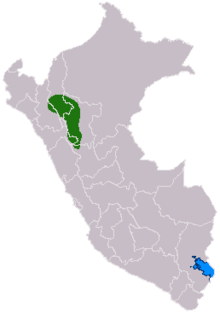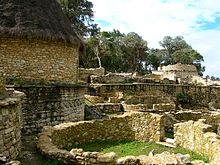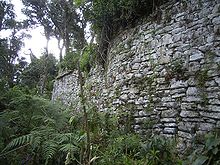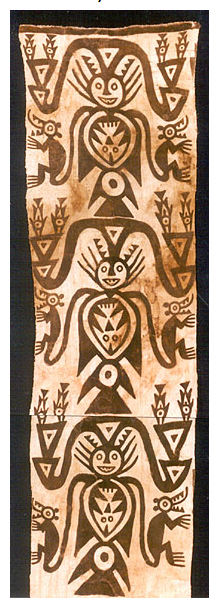
Pachacuti Inca Yupanqui, also called Pachacútec, was the ninth Sapa Inca of the Kingdom of Cusco which he transformed into the Inca Empire. Most archaeologists now believe that the famous Inca site of Machu Picchu was built as an estate for Pachacuti.

Atahualpa, also Atawallpa (Quechua), Atabalica, Atahuallpa, Atabalipa, was the last effective Inca emperor before his capture and execution during the Spanish conquest.

Huayna Capac was the third Sapa Inca of Tawantinsuyu, the Inca Empire. He was the son of and successor to Túpac Inca Yupanqui., the sixth Sapa Inca of the Hanan dynasty, and eleventh of the Inca civilization. He was born in Tumipampa and tutored to become Sapa Inca from a young age.

Cajamarca, also known by the Quechua name, Kashamarka, is the capital and largest city of the Cajamarca Region as well as an important cultural and commercial center in the northern Andes. It is located in the northern highlands of Peru at approximately 2,750 m (8,900 ft) above sea level in the valley of the Mashcon river. Cajamarca had an estimated population of about 226,031 inhabitants in 2015, making it the 13th largest city in Peru.

Amazonas is a department and region in northern Peru bordered by Ecuador on the north and west, Cajamarca on the west, La Libertad on the south, and Loreto and San Martín on the east. Its capital is the city of Chachapoyas.
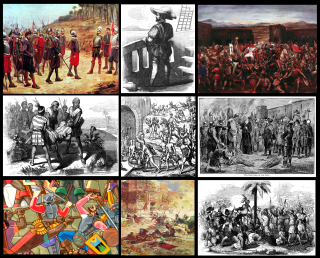
The Spanish conquest of the Inca Empire, also known as the Conquest of Peru, was one of the most important campaigns in the Spanish colonization of the Americas. After years of preliminary exploration and military skirmishes, 168 Spanish soldiers under conquistador Francisco Pizarro, along with his brothers in arms and their indigenous allies, captured the Sapa Inca Atahualpa in the 1532 Battle of Cajamarca. It was the first step in a long campaign that took decades of fighting but ended in Spanish victory in 1572 and colonization of the region as the Viceroyalty of Peru. The conquest of the Inca Empire, led to spin-off campaigns into present-day Chile and Colombia, as well as expeditions to the Amazon Basin and surrounding rainforest.

Manco Inca Yupanqui was the founder and monarch of the independent Neo-Inca State in Vilcabamba, although he was originally a puppet Inca Emperor installed by the Spaniards. He was also known as "Manco II" and "Manco Cápac II". He was one of the sons of Huayna Capac and a younger brother of Huascar.

Chinchay Suyu or Chinchasuyu was the northwestern provincial region of the Tawantin Suyu, or Inca Empire. The most populous suyu, Chinchasuyu encompassed the former lands of the Chimú Empire and much of the northern Andes. At its largest extent, the suyu extended through much of modern Ecuador and just into modern Colombia. Along with Antisuyu, it was part of the Hanan Suyukuna or "Upper Quarters" of the empire.

The Chincha culture was the culture of a Native Peruvian people living near the Pacific Ocean in south west Peru. The Chincha Kingdom and their culture flourished in the Late Intermediate Period, also known as the regional states period of pre-Columbian Peru. They became part of the Inca Empire around 1480. They were prominent as sea-going traders and lived in a large and fertile oasis valley. La Centinela is an archaeological ruin associated with the Chincha. It is located near the present-day city of Chincha Alta.
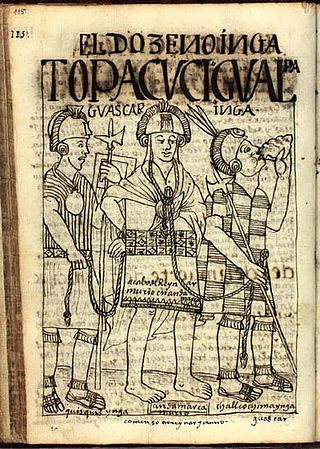
Quizquiz or Quisquis was, along with Chalcuchimac and Rumiñawi, one of Atahualpa's leading generals. In April 1532, along with his companions, Quizquiz led the armies of Atahualpa to victory in the battles of Mullihambato, Chimborazo and Quipaipan, where he, along with Chalkuchimac defeated and captured Huáscar and promptly killed his family, seizing capital Cuzco. Quizquiz later commanded Atahualpa's troops in the battles of Vilcaconga, Cuzco and Maraycalla (1534), ultimately being bested by the Spanish forces in both accounts.
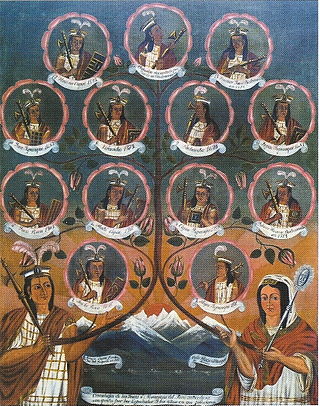
The Incas were most notable for establishing the Inca Empire which was centered in modern-day South America in Peru and Chile. It was about 2,500 miles from the northern to southern tip. The Inca Empire lasted from 1438 to 1533. It was the largest Empire in America throughout the Pre-Columbian era. The Inca state was known as the Kingdom of Cuzco before 1438. Over the course of the Inca Empire, the Inca used conquest and peaceful assimilation to incorporate the territory of modern-day Peru, followed by a large portion of western South America, into their empire, centered on the Andean mountain range. However, shortly after the Inca Civil War, the last Sapa Inca (emperor) of the Inca Empire was captured and killed on the orders of the conquistador Francisco Pizarro, marking the beginning of Spanish rule. The remnants of the empire retreated to the remote jungles of Vilcabamba and established the small Neo-Inca State, which was conquered by the Spanish in 1572.

Coricancha, Curicancha, Koricancha, Qoricancha or Qorikancha was the most important temple in the Inca Empire, and was described by early Spanish colonialists. It is located in Cusco, Peru, which was the capital of the empire.
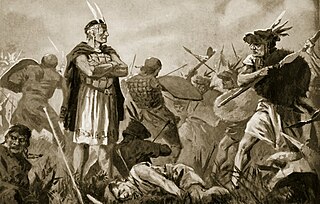
The Inca Civil War, also known as the Inca Dynastic War, the Inca War of Succession, or, sometimes, the War of the Two Brothers, was fought between half-brothers Huáscar and Atahualpa, sons of Huayna Capac, over succession to the throne of the Inca Empire. The war followed Huayna Capac's death.
Tumebamba, Tomebamba, or Tumipampa was a former main regional city in the Inca Empire. Tumebamba was chosen by the Emperor Huayna Capac to be the Inca northern capital. The city was largely destroyed during the civil war between Huáscar and Atahualpa shortly before the arrival of the Spanish conquistadors in 1532. The Spanish city of Cuenca, Ecuador was built on the site of Tumebamba although a portion of the Inca city is preserved at the archaeological sites of Pumapunku and Todos Santos.

The Comentarios Reales de los Incas is a book written by Inca Garcilaso de la Vega, the first published mestizo writer of colonial Andean South America. The Comentarios Reales de los Incas is considered by most to be the unquestioned masterpiece of Inca Garcilaso de la Vega, born of the first generation after the Spanish conquest.

Pre-Columbian Ecuador included numerous indigenous cultures, who thrived for thousands of years before the ascent of the Incan Empire. Las Vegas culture of coastal Ecuador, flourishing between 8000 and 4600 BC, is one of the oldest cultures in the Americas. The subsequent Valdivia culture in the Pacific coast region is another well-known early Ecuadorian culture. Ancient Valdivian artifacts from as early as 3500 BC have been found along the coast north of the Guayas Province in the modern city of Santa Elena.

The Andean civilizations were South American complex societies of many indigenous people. They stretched down the spine of the Andes for 4,000 km (2,500 mi) from southern Colombia, to Ecuador and Peru, including the deserts of coastal Peru, to north Chile and northwest Argentina. Archaeologists believe that Andean civilizations first developed on the narrow coastal plain of the Pacific Ocean. The Caral or Norte Chico civilization of coastal Peru is the oldest known civilization in the Americas, dating back to 3500 BCE. Andean civilization is one of the six "pristine" civilizations of the world, created independently and without influence by other civilizations.
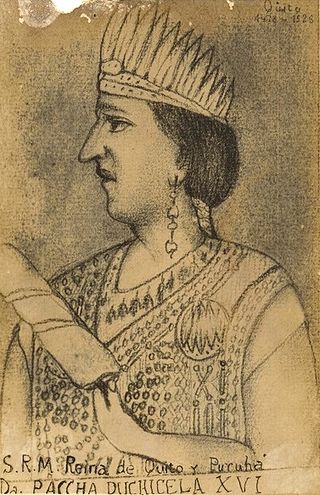
Paccha Duchicela (1485–1525), was, according to the priest Juan de Velasco, a queen regnant of Quito in 1487–1525 and co-reigned with her husband Huayna Capac, the Emperor of Inca Empire. As all the kings and queens of Quito, she is only mentioned by de Velasco. She was also a consort of the Inca Empire by marriage to the Sapa Inca Huayna Capac. She has been pointed out as the mother of Atahualpa.

The history of Cusco (Peru), the historical capital of the Incas.
The Inca-Caranqui archaeological site is located in the village of Caranqui on the southern outskirts of the city of Ibarra, Ecuador. The ruin is located in a fertile valley at an elevation of 2,299 metres (7,543 ft). The region around Caranqui, extending into the present day country of Colombia, was the northernmost outpost of the Inca Empire and the last to be added to the empire before the Spanish conquest of 1533. The archaeological region is also called the Pais Caranqui.
